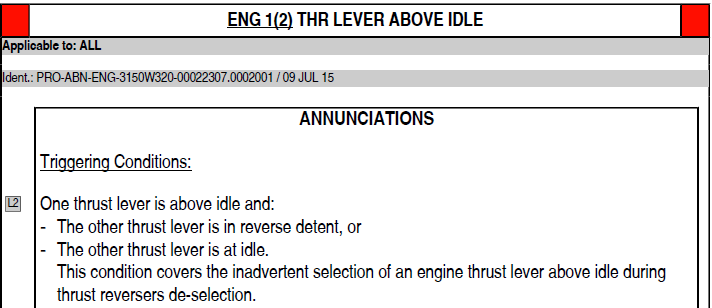这个警告的触发条件写得很简单,就是一个高于 IDLE,另一个在 IDLE 或者反推位。主要是为了在应该都收到慢车或者反推的情况下提示机组还有一发没收下来。然后值得注意的是,触发阶段也包含了 PHASE 8&9,也就是空中。那假设在发动机喘振的情况下,机组将一发收到慢车,这个警告会出现让机组将另一发也收到慢车么?这明显不合理。
空客的解释是PHASE 8 和9 是在10之后弹跳才进入的,由于具体的条件非常复杂,并不能在抑制表中体现。总之就是并不是只要在 PHASE 8和9就有可能触发这个警告。具体参考 TechRequest 原文:
Q:
The meaning of the alert, in my understanding, is notifing crew to set thrust lever to ILDE when needed.
However, the triggering phases includes 8 and 9. If in eng stall or manual flight, crew set one lever at IDLE intentionally, the triggering condition shows this alert will appear. Will it make confusion to crew? It sounds like "oh, you should set another lever to IDLE too".
A:
ENG 1(2) THR LEVER ABOVE IDLE is triggered on the ground (normally during T.O or Landing roll above 40 KTS) if one THR LVR is above idle and the other THR LVR is in REV detent or the other THR LVR is at IDLE, the crew SHALL SET affect LVR to IDLE and follow the SOP for landing.
Q_2:
The "Flight Phase Inhinition" shows this alert can be trigger in phase 8 & 9 which are not on ground. For example, in case of ENG STALL on simulator, we can set one thrust lever at IDLE, and another one at MCT or CLB (above IDLE). Although this case already conform the triggering conditoin, we never saw it triggered.
There're 2 cases of one lever at IDLE or REV and another above IDLE. Case 1 is we should set both above IDLE, and case 2 is both at IDLE or REV. The alert about these two cases should be the same. However, the triggering condition of ENG 1(2) THR LEVER ABOVE IDLE doesn't distinguish them.
A_2:
We confirm that your understanding is correct.
The purpose of the ECAM ENG 1(2) THR LEVER ABOVE IDLE is indeed to remind the crew that one thrust lever must be set to the IDLE position. As per design, the message (associated with Dual Retard automatic call out) is activated on ground following a rejected Take-off or after landing. As mentioned, the alert can be triggered in flight phases 8 & 9 but only if the aircraft was previously in flight phase 10 (bounce situation).
Finally, please keep in mind that the Flight Phase Inhibition section in the FCOM provides information to the crew in regards to the flight phases during which the alert is inhibited by logic
but does not necessary indicate that the alert can appear in the other phases.
In the case of the message ENG 1(2) THR LEVER ABOVE IDLE, multiple conditions (too much complex to be entirely described) may then prevent the apparition of the alert in the “allowed flight phases” (aircraft speed, other displayed alerts, etc.).

